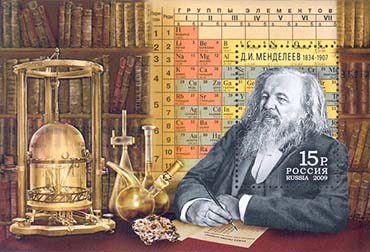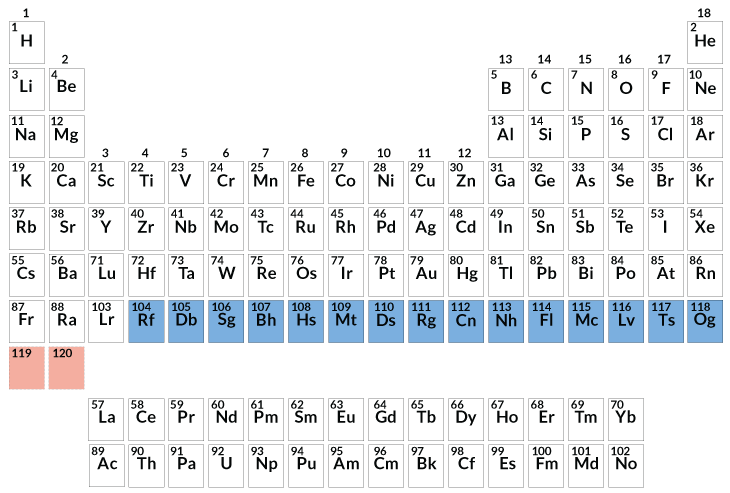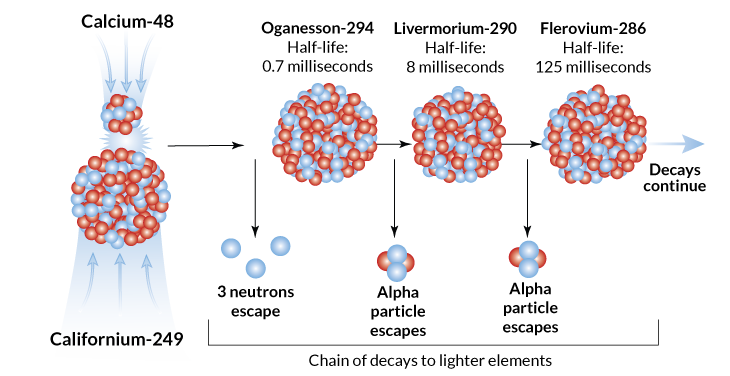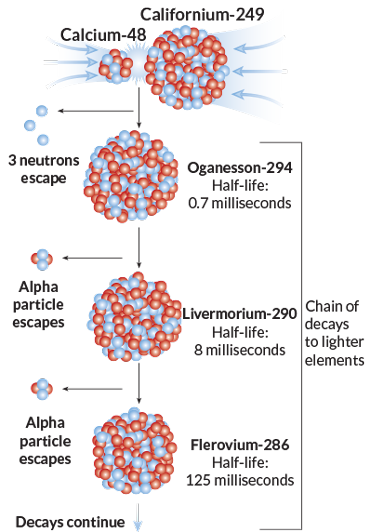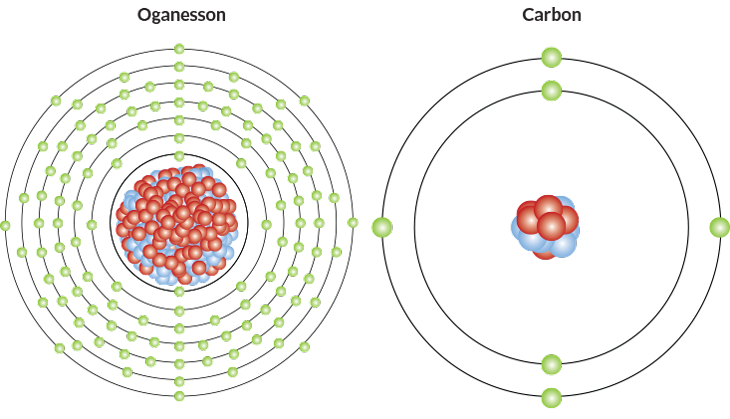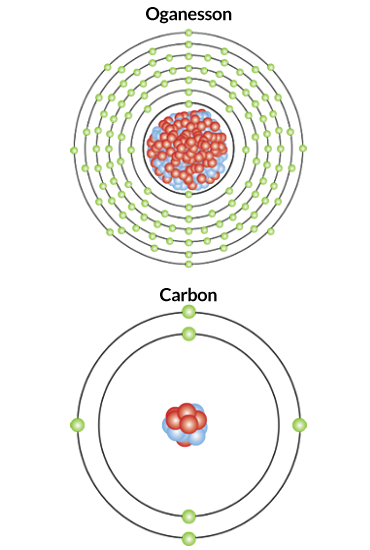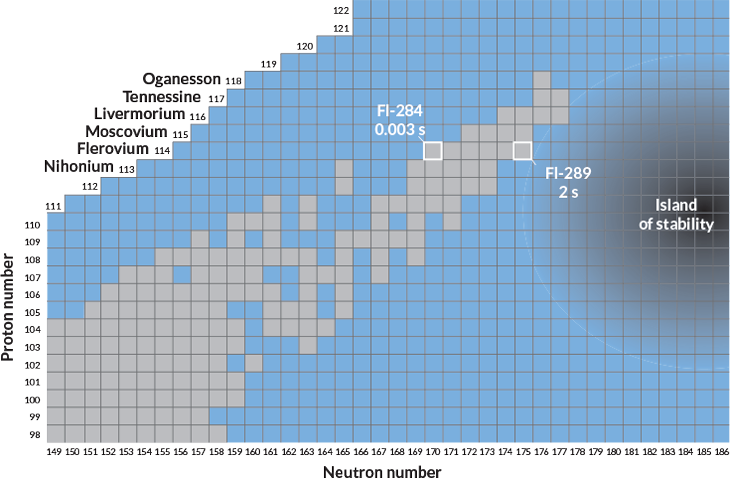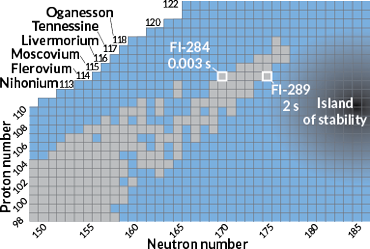Extreme elements push the boundaries of the periodic table
For superheavy atoms, chemistry gets weird

SMASH HIT To create new elements and study the chemistry of the periodic table’s heaviest atoms, researchers at the GSI Helmholtz Center for Heavy Ion Research in Darmstadt, Germany, use the apparatus above to create beams of ions that scientists then smash into other elements.
GSI Helmholtzzentrum für Schwerionenforschung GmbH/Jan Michael Hosan 2018
The rare radioactive substance made its way from the United States to Russia on a commercial flight in June 2009. Customs officers balked at accepting the package, which was ensconced in lead shielding and emblazoned with bold-faced warnings and the ominous trefoil symbols for ionizing radiation. Back it went across the Atlantic.
U.S. scientists enclosed additional paper work and the parcel took a second trip, only to be rebuffed again. All the while, the precious cargo, 22 milligrams of an element called berkelium created in a nuclear reactor at Oak Ridge National Laboratory in Tennessee, was deteriorating. Day by day, its atoms were decaying. “We were all a little frantic on our end,” says Oak Ridge nuclear engineer Julie Ezold.
On the third try, the shipment cleared customs. At a laboratory in Dubna, north of Moscow, scientists battered the berkelium with calcium ions to try to create an even rarer substance. After 150 days of pummeling, the researchers spotted six atoms of an element that had never been seen on Earth. In 2015, after other experiments confirmed the discovery, element 117, tennessine, earned a spot on the periodic table (SN: 2/6/16, p. 7).
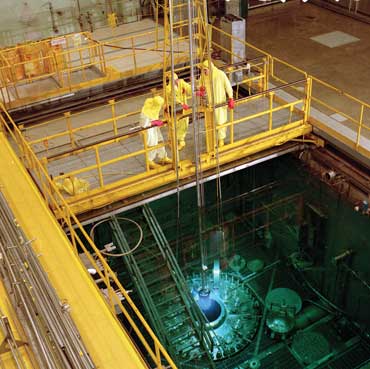
Scientists are hoping to stretch the periodic table even further, beyond tennessine and three other recently discovered elements (113, 115 and 118) that completed the table’s seventh row. Producing the next elements will require finessing new techniques using ultrapowerful beams of ions, electrically charged atoms. Not to mention the stress of shipping more radioactive material across borders.
But questions circulating around the periodic table’s limits are too tantalizing not to make the effort. It’s been 150 years since Russian chemist Dmitrii Mendeleev created his periodic table. Yet “we still cannot answer the question: Which is the heaviest element that can exist?” says nuclear chemist Christoph Düllmann of the GSI Helmholtz Center for Heavy Ion Research in Darmstadt, Germany.
At the far edge of the periodic table, elements decay within instants of their formation, offering very little time to study their properties. In fact, scientists still know little about the latest crew of newfound elements. So while some scientists are hunting for never-before-seen elements, others want to learn more about the table’s newcomers and the strange behaviors those superheavy elements may exhibit.
For such outsized atoms, chemistry can get weird, as atomic nuclei, the hearts at the center of each atom, bulge with hundreds of protons and neutrons. Around them swirl great flocks of electrons, some moving at close to the speed of light. Such extreme conditions might have big consequences — messing with the periodic table’s tidy order, in which elements in each column are close chemical kin that behave in similar ways.
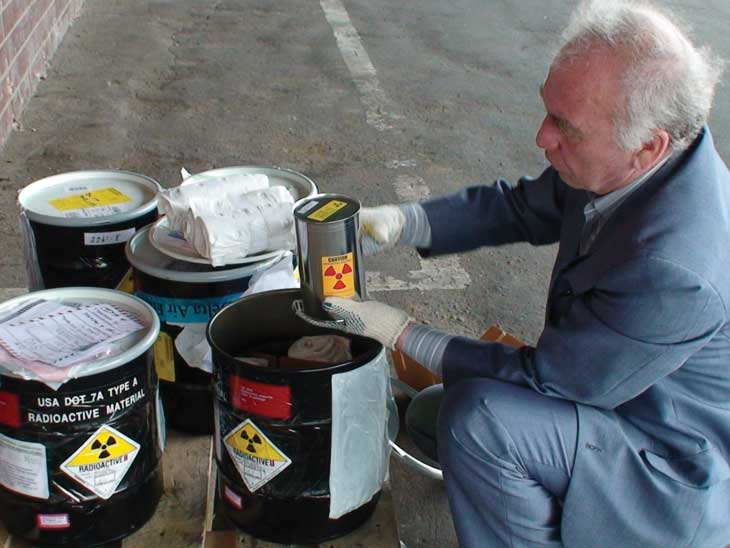
Scientists keep pushing these superheavy elements further as part of the search for what’s poetically known as the island of stability. Atoms with certain numbers of protons and neutrons are expected to live longer than their fleeting friends, persisting perhaps for hours rather than fractions of a second. Such an island would give scientists enough time to study those elements more closely and understand their quirks. The first glimpses of that mysterious atoll have been spotted, but it’s not clear how to get a firm footing on its shores.
Driving all this effort is a deep curiosity about how elements act at the boundaries of the periodic table. “This might sound corny, but it’s really just [about] pure scientific understanding,” says nuclear chemist Dawn Shaughnessy of Lawrence Livermore National Laboratory in California. “We have these things that are really at the extremes of matter and we don’t understand right now how they behave.”
Assembling atoms
An element is defined by the number of protons it contains. Create an atom with more protons than ever before, and you’ve got yourself a brand new element. Each element comes in a variety of types, known as isotopes, distinguished by the number of neutrons in the nucleus. Changing the number of neutrons in an atom’s nucleus alters the delicate balance of forces that makes a nucleus stable or that causes it to decay quickly. Different isotopes of an element might have wildly different half-lives, the period of time it takes for half of the atoms in a sample to decay into smaller elements.
Mendeleev’s periodic table, presented to the Russian Chemical Society on March 6, 1869, contained only 63 elements (SN: 1/19/19, p. 14). At first, scientists added to the periodic table by isolating elements from naturally occurring materials, for example, by scrutinizing minerals and separating them into their constituent parts. But that could take scientists only so far. All the elements beyond uranium (element 92) must be created artificially; they do not exist in significant quantities in nature. Scientists discovered elements beyond uranium by bombarding atoms with neutrons or small atomic nuclei or by sifting through the debris from thermonuclear weapons tests.
But to make the heaviest elements, researchers adopted a new brute force approach: slamming beams of heavy atoms into a target, a disk that holds atoms of another element. If scientists are lucky, the atoms in the beam and target fuse, creating a new atom with a bigger, bulkier nucleus, perhaps one holding more protons than any other known.
Researchers are using this strategy to go after elements 119 and 120. Scientists want to create such never-before-seen atoms to test how far the periodic table goes, to satisfy curiosity about the forces that hold atoms together and to understand what bizarre chemistry might occur with these extreme atoms.
Coaxing nuclei to combine into a new element is done only at highly specialized facilities in a few locations across the globe, including labs in Russia and Japan. Researchers carefully choose the makeup of the beam and the target in hopes of producing a designer atom of the element desired. That’s how the four newest elements were created: nihonium (element 113), moscovium (115), tennessine (117) and oganesson (118) (SN Online: 11/30/16).
To create tennessine, for example, scientists combined beams of calcium with a target made of berkelium — once the berkelium finally made it through customs in Russia. The union makes sense when you consider the number of protons in each nucleus. Calcium has 20 protons and berkelium has 97, making for 117 protons total, the number found in tennessine’s nucleus. Combine calcium with the next element down the table, californium, and you get element 118, oganesson.
Using calcium beams — specifically a stable calcium isotope with a combined total of 48 protons and neutrons known as calcium-48 — has been highly successful. But to create bigger nuclei would take increasingly exotic materials. The californium and berkelium used in previous efforts are so rare that the target materials had to be made at Oak Ridge, where researchers stew materials in a nuclear reactor for months and carefully process the highly radioactive product that comes out. All that work might produce just milligrams of the material.
To discover element 119 using a calcium-48 beam, researchers would need a target made of einsteinium (element 99) which is even rarer than californium and berkelium. “We can’t make enough einsteinium,” says Oak Ridge physicist James Roberto. Scientists need a new approach. They’ve switched to relatively untested techniques relying on different beams of particles.
But any new approach would have to produce new elements often enough to be worthwhile. It took almost nine years for a Japanese experiment to prove the existence of nihonium. In that time, researchers spotted the element only three times.
To avoid such long waits, scientists are carefully choosing their tactics and revving up improved machines to quicken the search.
A team at the RIKEN Nishina Center for Accelerator-Based Science near Tokyo uses beams of vanadium (element 23), rather than calcium, slamming them into curium (element 96) in the quest to grab elemental glory and find element 119. The group is starting with an existing accelerator and will soon switch to an accelerator upgraded to pump out ion beams that pack more punch. That revamped accelerator could be ready within a year, says RIKEN nuclear chemist Hiromitsu Haba.
Meanwhile, a new laboratory at the Joint Institute for Nuclear Research, or JINR, in Dubna called the Superheavy Element Factory boasts an accelerator that will crank out ion beams that pummel the target at 10 times the rate of its predecessor. In an upcoming experiment, scientists plan to crash beams of titanium (element 22) into berkelium and californium targets to attempt to produce elements 119 and 120.
Once JINR’s new experiment is up and running, 119 might be discovered after a couple of years, says JINR nuclear physicist Yuri Oganessian, for whom oganesson, one of several elements discovered there, was named.
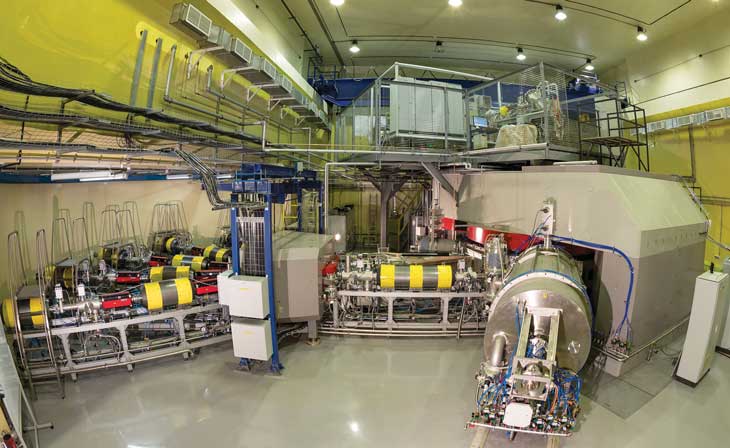
Relativity rules
Simply detecting an element, however, doesn’t mean scientists know much about it. “How would one kilogram of flerovium behave, if I had it?” Düllmann asks, referring to element 114. “It would be unlike any other material.”
The known superheavy elements — those beyond number 103 on the table — are too short-lived to create a chunk big enough to hold in the palm of your hand. So scientists are limited to studying individual atoms, getting to know each new element by analyzing its properties, including how easily it reacts with other substances.
One big question is whether the periodicity the table is named for applies to superheavy elements. In the table, elements are ordered according to their number of protons, arranged so that the elements in each column have similar properties. Lithium, sodium and others in the first column react violently with water, for example. Elements in the last column, known as noble gases, are famously inert (SN: 1/19/19, p. 18). But for the newest, heaviest elements at the periodic table’s outer reaches, that long-standing rule of chemistry may unravel; some superheavy elements may behave differently from neighbors sitting above them in the table.
For nuclei crammed with 100-plus protons, a special type of physics takes center stage. Electrons zip around these giant nuclei, sometimes surpassing 80 percent the speed of light. According to Einstein’s special theory of relativity, when particles move that fast, they seem to gain mass. That property changes how closely the electrons hug the nucleus, and as a result, how easily the atoms share electrons to produce chemical reactions. In such atoms, “relativity rules, and standard common wisdom breaks down,” says nuclear physicist Witold Nazarewicz of Michigan State University in East Lansing. “We have to write new textbooks on those atoms.”
Some of the periodic table’s more familiar elements are already affected by special relativity. The theory explains why gold has a yellowish hue and why mercury is liquid at room temperature (SN: 2/18/17, p. 11). “Without relativity, a car would not start,” says theoretical chemist Pekka Pyykkö of the University of Helsinki. The reactions that power a car battery depend on special relativity.
Relativity’s influence may surge as scientists progress along the periodic table. In 2018 in Physical Review Letters, Nazarewicz and colleagues reported that oganesson could be utterly bizarre (SN Online: 2/12/18). The table’s heaviest element, oganesson sits among the reclusive noble gases that shun reactions with other elements. But oganesson bucks the trend, theoretical calculations suggest, and may instead be reactive.
Oganesson’s chemistry is a hot topic, but scientists haven’t yet been able to directly probe its properties with experiments because oganesson is too rare and fleeting. “All the theoreticians are now running around this element trying to make spectacular predictions,” says theoretical chemist Valeria Pershina of GSI. Similarly, some calculations suggest that flerovium might lean in the opposite direction, being relatively inert, even though it inhabits the same column as more reactive elements such as lead.
Chemists are striving to test such calculations about how superheavy elements behave. But there is nothing traditional about these chemistry experiments. There are no scientists in white coats wielding flasks and Bunsen burners. “Because we make these things one atom at a time, we can’t do what most people think of as chemistry,” Lawrence Livermore’s Shaughnessy says.
The experiments can run for months with only a few atoms to show for it. Scientists put those atoms in contact with other elements to see if the two react. At GSI, Düllmann and colleagues are looking at whether flerovium sticks to gold surfaces. Likewise, Shaughnessy and colleagues are testing whether flerovium will glom on to ring-shaped molecules, chosen so that the heavy element could fit inside the molecule’s ring. These studies will test how easily flerovium bonds with other elements, revealing whether it behaves as expected based on its place on the periodic table.
It’s not just chemical reactions that can get wacky for superheavy elements. Atomic nuclei can be warped into various shapes when packed with protons. Oganesson may have a “bubble” in its nucleus, with fewer protons in its center than at its edges (SN: 11/26/16, p. 11). Still more extreme nuclei may be doughnut-shaped, Nazarewicz says.
Even the most basic properties of these elements, such as their mass, need to be measured. While scientists had estimated the mass of the various isotopes of the latest new elements using indirect measurements, the arguments supporting those mass estimates weren’t airtight, says Jacklyn Gates of Lawrence Berkeley National Laboratory in California. “They hinge on physics not throwing you a curveball.”
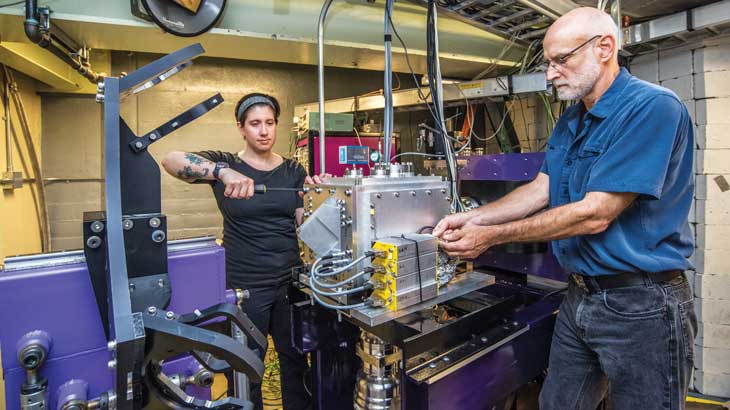
So Gates and colleagues directly measured the masses of isotopes of nihonium and moscovium using an accelerator at Lawrence Berkeley. An apparatus called FIONA helped researchers measure the masses, thanks to electromagnetic fields that steered an ion of each element onto a detector. The location where each ion hit indicated how massive it was.
The nihonium isotope the researchers detected had a mass number of 284, meaning its nucleus had a combined total of 284 protons and neutrons. Moscovium had a mass number of 288. Those masses were as predicted, the scientists reported in November in Physical Review Letters. It took about a month just to find one atom of each element.
Island views
If researchers could coax these fleeting elements to live longer, studying their properties might be easier. Scientists have caught enticing visions of increasing life spans lying just out of reach — the fabled island of stability (SN: 6/5/10, p. 26). Scientists hope that the isotopes on that island, which would be packed with lots of neutrons, may live long enough that their chemistry can be studied in detail.
When the idea of an island of stability was proposed in the 1960s, scientists had suggested that the isotopes on its shores might live millions of years. Advances in theoretical physics have since knocked that time frame down, Nazarewicz says. Instead, nuclear physicists now expect the island’s inhabitants to stick around for minutes, hours or maybe even a day — a pleasant eternity for superheavy elements.
To reach the island of stability, scientists must create new isotopes of known elements. Researchers already know which direction they need to row: They must cram more neutrons into the nuclei of the superheavy elements that have already been discovered. Currently, scientists can’t make atoms with enough neutrons to reach the island’s center, where isotopes are expected to be most stable. But the signs of this island’s existence are already clear. The half-lives of superheavy elements tend to shoot up as scientists pack more neutrons into each nucleus, approaching the island. Flerovium’s half-life increases by almost a factor of 700 as five more neutrons are added, from three milliseconds to two seconds.
Reaching this island “is our big dream,” Haba says. “Unfortunately, we don’t have a very good method to reach the island.” That island is thought to be centered around isotopes that bulge with around 184 neutrons and something like 110 protons. Making such neutron-rich nuclei would demand new, difficult techniques, such as using beams of radioactive particles instead of stable ones. Although radioactive beams can be produced at RIKEN, Haba says, the beams aren’t intense enough to produce new elements at a reasonable rate.
Still, superheavy element sleuths are keeping at it to learn how these weird atoms behave.
End of the line
To fully grasp nature’s extremes, scientists want to know where the periodic table ends.
“Everybody knows at some point there will be an end,” Düllmann says. “There will be a heaviest element, ultimately.” The table will be finished when we’ve discovered all elements with isotopes that live at least a hundredth of a trillionth of a second. That’s the limit for what qualifies as an element, according to the standards set by the International Union of Pure and Applied Chemistry. More ephemeral nuclei wouldn’t have enough time to gather a crew of electrons. Since the give-and-take of electrons is the basis of chemical reactions, lone nuclei wouldn’t exhibit chemistry at all, and therefore don’t deserve a spot on the table.
“Where it will exactly end is difficult to say,” Nazarewicz says. Calculations of how quickly a nucleus will decay by fission, or splitting in two, are uncertain, which makes it hard to estimate how long elements might live without actually creating them.
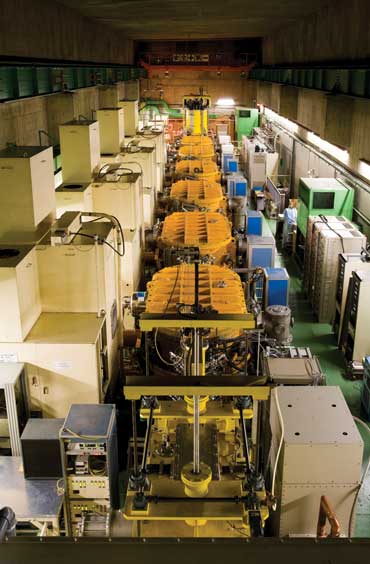
And the final table may contain holes or other odd features. That could happen if, within a row of elements, there’s one spot for which no isotope persists long enough to qualify as an element.
Another idiosyncrasy: Elements may not be arranged in sequential order by the number of protons they contain, according to calculations in a 2011 paper by Pyykkö in Physical Chemistry Chemical Physics. Element 139, for example, might sit to the right of element 164 — if such heavy elements indeed exist. That’s because special relativity alters the normal order in which electrons slot themselves into shells, arrangements that define how the electrons swirl about the atom. That pattern of shell filling is what gives the periodic table its shape, and the unusual filling may mean scientists decide to assign elements to spots out of order.
But additions to the table could dry up before that happens if scientists reach the limit of their ability to create heavier elements. When elements live minuscule fractions of a second, even the atom’s trip to a detector may take too long; the element would decay before it ever had a chance to be spotted.
In reality, there’s no clear idea of how to search for elements beyond 119 and 120. But the picture has seemed bleak before.
“We should not underestimate the next generation. They may have smart ideas. They will have new technologies,” Düllmann says. “The next element is always the hardest. But it’s probably not the last one.”
